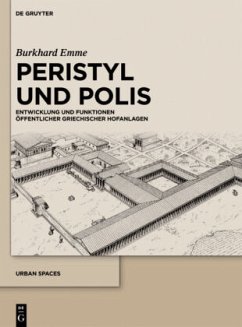Peristyle buildings fulfilled a range of public functions in Greek cities, serving as religious sites, banquet halls, gymnasiums, government offices, and markets. Yet all peristyle buildings are united in their spatial organization around a central courtyard. As a result, they are open toward the center but closed off to the outside. This observation forms the basis for the author's thesis that peristyle structures served in general to generate closed off spaces only accessible to exclusive groups. The investigation of this thesis is founded on a number of individual studies. These studies present us with the picture of a carefully planned system that allowed for the structures to appear hermetically closed from the outside while at the same time open to multiple rooms from a central courtyard on the inside. The author locates this design scheme within the broader scope of Classical architectural and social history. He shows that the development and rapid spread of the peristyle structures in the 4th century B.C. was closely related to a simultaneous process in which urban structures in Greek cities became more monumental and diverse. The work thus addresses a phenomenon of wide-reaching significance with detailed investigations of specific structures.
Peristylbauten konnten innerhalb der griechischen Städte eine Vielzahl von öffentlichen Funktionen erfüllen: Sie dienten als Heiligtümer, Bankettbauten, Gymnasia, Amtslokale oder Marktgebäude. Allen Bauten gemein ist jedoch ihre räumliche Organisation um den zentralen Hof sowie die damit einhergehende Abgeschlossenheit nach außen. Diese Beobachtung bildet den Ausgangspunkt für die These, dass die Bauform allgemein zur Ausbildung abgeschlossener Räume für exklusive Personengruppen diente. Die Grundlage der Untersuchung bilden zahlreiche Einzelstudien. Aus diesen ergibt sich das Bild eines bis in die Einzelheiten durchdachten Systems, das die Bauten von außen hermetisch abgeschlossen wirken ließ, während sich im Inneren zahlreiche Räume auf den zentralen Hof öffneten. Anschließend erfolgt die Einordnung des Phänomens in den weiteren Rahmen der antiken Architektur- und Gesellschaftsgeschichte. Der Autor weist nach, dass Aufkommen und rasche Verbreitung des peristylen Baugedankens im 4. Jh. v. Chr. in engem Zusammenhang mit dem gleichzeitig stattfindenden Prozess der Monumentalisierung und Diversifizierung griechischer Städte zu sehen sind. Die Arbeit verbindet somit eine umfassende Fragestellung mit materialorientierten Detailuntersuchungen.
Peristylbauten konnten innerhalb der griechischen Städte eine Vielzahl von öffentlichen Funktionen erfüllen: Sie dienten als Heiligtümer, Bankettbauten, Gymnasia, Amtslokale oder Marktgebäude. Allen Bauten gemein ist jedoch ihre räumliche Organisation um den zentralen Hof sowie die damit einhergehende Abgeschlossenheit nach außen. Diese Beobachtung bildet den Ausgangspunkt für die These, dass die Bauform allgemein zur Ausbildung abgeschlossener Räume für exklusive Personengruppen diente. Die Grundlage der Untersuchung bilden zahlreiche Einzelstudien. Aus diesen ergibt sich das Bild eines bis in die Einzelheiten durchdachten Systems, das die Bauten von außen hermetisch abgeschlossen wirken ließ, während sich im Inneren zahlreiche Räume auf den zentralen Hof öffneten. Anschließend erfolgt die Einordnung des Phänomens in den weiteren Rahmen der antiken Architektur- und Gesellschaftsgeschichte. Der Autor weist nach, dass Aufkommen und rasche Verbreitung des peristylen Baugedankens im 4. Jh. v. Chr. in engem Zusammenhang mit dem gleichzeitig stattfindenden Prozess der Monumentalisierung und Diversifizierung griechischer Städte zu sehen sind. Die Arbeit verbindet somit eine umfassende Fragestellung mit materialorientierten Detailuntersuchungen.








